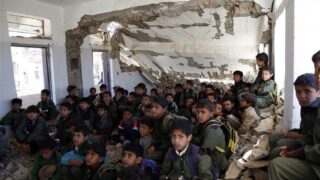
This publication has benefited from the support of the Rosa Luxemburg Foundation. This text may be reproduced in part or in full, provided the source is acknowledged.
In the beginning of his rule in the mid 1970s, late President Ibrahim al-Hamdi visited the Thula Fort in ‘Amran Governorate in northern Yemen and sat in one of its watchtowers (1). His eldest brother was there with him, and he would later tell of the backstabbed president’s gaze into the dark horizon that day, as he spoke of the two main goals of his five-year plan: rural electrification and the reforestation of barren land, including mountain areas. According to his eldest brother, the president then wished for Yemen’s climate to retrieve its ancient patterns, when rain would fall for six months a year and the water springs would flow for the remainder of the year (2).
These weren’t mere wishes, but rather a timely climate initiative that preceded sounding the alarm of climate change at the highest levels of leadership across the world. A year after he assumed the presidential office, Al-Hamdi issued a document titled “Reforestation Objectives and Stages of Implementation”. It was set up with three phases in mind over the period (1975-1978), by planting nine million trees, at a rate of three million a year.
To expand participation in the reforestation plan, the president issued a decree, which considered the 1st of March to be Tree Day. During that day, students, residents, and the military would volunteer to plant trees which were distributed for free by the government. During Al-Hamdi’s less than three years in presidency, six million trees were planted (3), some of which stood by the roadsides and on the mountains for years; that is, until the pickaxes of arbitrary logging destroyed them during the last eight war-ravaged years.
Climate Change: It’s About Time!
29-12-2022
The Struggle for Climate Justice in the Arab Region
21-01-2023
Yemen is currently facing its worst climate change scenarios, as the spectre of war and several other ugly spectres continue to hover, like the hazards of food and water security, as drought indicators and rainfall reach an extreme, levelling agricultural lands and causing other future disasters. The path that climate change in the country has taken is worrisome, especially with turbulent climate phenomena, coupled with political and economic instability. In fact, the situation of the Yemeni population and the capacity of state institutions, ravaged by war and division, cannot withstand any further delays in implementing measures domestically, neither can they tolerate any regional or international stagnation, as the promises of the developed world remain dormant, year in and year out.
Amidst this distressing and vague reality, the question is posed concerning the Internationally Recognized Government (IRG) and the de facto power in Sanaa assuming their responsibilities in facing climate changes. Likewise, the efficacy of pledging funds – both global and regional – to Yemen, considered one of the least developed countries to face these hazards, is yet another question to address, as is the question of when the first step would be actually be implemented.
Meeting the crisis with adaptation
The speech given by the Chairman of the Presidential Leadership Council, Rashad al-Alimi, at the Sharm el-Sheikh Climate Change Conference (COP27) in Egypt (November 6th-18th, 2022) may offer a few clues to the IRG’s view of climate change hazards and the extent to which it can handle them. Al-Alimi called for “speeding up” the fulfilment of those promises made by industrial countries to reduce greenhouse gas emissions, “build Yemen’s ability to adapt, and multiply funding to that end…” He also reminded world leaders that Yemen was, and still is, one of the most drought-susceptible countries in the region, which would be yet another cause for “civil conflict over water and land”. Al-Alimi demanded that world leaders also enable his government to “administer its own fair share of the financial initiative” for the least developed and most vulnerable countries. He also considered that they held what he called overlapping responsibilities to help the government “reconstruct its institutions” that have been operating well below capacity due to the war, migration, and the devastation of State infrastructures (4).
Yemen: Instability Hits the Climate Too
09-11-2022
Considering the current climate situation in Yemen and the activities and measures carried out by the two main warring parties, the Houthis (the Sanaa Authority) and the IRG, it appears that the two sides’ efforts have been moving in two parallel paths that do not meet the level of action required to handle the destructive impacts of climate change on the entire country. As the Sanaa Authority tries to trace President Al-Hamdi’s plan for reforestation and agricultural land reclamation, its high-ranking officials speak neither of carbon emissions, extreme rainfall, rising temperatures, nor of other climate change phenomena. While tree seedlings used to be distributed for free during President Al-Hamdi’s rule, expert parties in the Sanaa Authority prohibited the free distribution of reforestation seedlings. Meanwhile, it focuses on cultivating coffee beans and almonds, both of which are considered cash crops… In October 2022, a meeting was announced by the Houthi-founded Higher Authority for Science, Technology, and Innovation (HASTI). It issued statements by authority officials on “the relationship between climate change and the right to development” and on “shifting towards green, adaptable technologies .”(5)
On the other hand, there are signs that the IRG, although more aware of the risks of climate change, is less active than the Sanaa Authority in the practical aspects of reforestation and agriculture. Having maintained a large number of qualified personnel in the State administration apparatus could help it progress, should it invest their capacities and manage their efforts properly. However, climate work within the official governmental channels has remained obstructed since 2015, when the war took its biggest turn as the Houthis (the Ansar Allah Movement) completed their coup d’état in January, and as Saudi Arabia and the UAE carried out an intervention in late March against the movement and its ally, late President Ali Abdullah Saleh.
Practically, no independent institution dedicated to the climate exists in Yemen, and the body directly in charge of the issue is an administrative unit in the Public Authority for the Environment, affiliated with the Ministry of Water and Environment. In 2015, and in coincidence with the Paris Climate Agreement, all climate action in the governmental institution came to a complete halt, all the way until 2021, when the Ministry of Water and the Environment reactivated the Climate Change Unit to carry out studies and design action plans that conform to international standards in financing climate efforts in the country (6). Since 2021, the Climate Change Unit has worked on an action plan for a national adaptation project, which was presented to the Green Climate Fund – one of the authorities affiliated with the United Nations Framework Convention on Climate Change (UNFCCC).
No independent institution dedicated to the climate exists in Yemen, and the body directly in charge of the issue is an administrative unit in the Public Authority for the Environment, affiliated with the Ministry of Water. In 2015, climate work in the governmental institution came to a complete halt, all the way until 2021, when the Ministry of Water and the Environment reactivated the Climate Change Unit to carry out studies and design action plans that conform to international standards.
The Sanaa Authority prohibited the distribution of reforestation seedlings for free, as it focuses on cultivating coffee beans and almonds, both of which are considered cash crops. In October 2022, a meeting was announced by the Houthi-founded Higher Authority for Science, Technology, and Innovation (HASTI). It issued statements by authority officials on “the relationship between climate change and the right to development” and “shifting towards green, adaptable technologies.”
The Yemeni official plan, presented in November 2015, implied that the authorities were willing to contribute to the reduction of greenhouse gas emissions, based on the support offered them by the international community. In that document, the government determined two types of cooperation: the first is unconditional, and implies a 1% reduction in greenhouse gas emissions by 2030, while the second is conditioned on an increase in the planned international support compared with the previous year (2014), where it would reduce greenhouse gas emissions by 13% in that same period – depending on new climate measures too, such as the Green Climate Fund. In 2015, the government was supposed to update the details of the support needed by 2020, but the war was in its first year then, quickly escalating, and so everything came to a halt (7).
Yemen joined the UNFCCC in 1996 and the Kyoto Protocol in 2008 as an unaffiliated party. The Environment Protection Authority (EPA) still acts as the official representative of the Yemeni government there. In the COP27, an EPA delegation, headed by the Minister of Water and Environment, was present. Yemen’s detailed situation, however, and that of other underdeveloped countries, is still unknown in terms of the negotiations carried out at the conference. According to the unit’s director in the EPA, Abdul Wahid Arman, the official team charged with drawing up plans and outlooks is still working on completing the draft study of needs assessment, along with updating the national climate strategy, which was formulated before the war broke out. Meanwhile, the Yemeni official plan on facing climate change focuses on adaptation.
The Adaptation Plan and COP27 negotiations
In an official study conducted by a team at the Ministry of Water in 2009, titled the “National Adaptation Plan for Climate Changes”, it was mentioned that the government aimed to reduce warming rates in Yemen down to 1.4-2.8 °C by 2050. The plan presented seven lines of action for adaptation: water, agriculture and food security, biodiversity, protecting coastal communities, consolidating the ecological infrastructure in coastal areas, healthcare, and tourism. The plan mainly aimed to determine priorities in the context of the country’s adaptation with climate change and its variations. Besides adaptation, the governmental team is working on updating the plan and extending its timeframe, but has yet to determine the scope to be covered. The Yemen climate negotiations also encompassed chapters on mitigation strategies and the inclusion of Yemen in the Loss and damage Fund as one of the least developed countries.
In the COP27, only five Yemeni negotiators were present.
Abdul Wahid Arman, who was chosen as the official spokesperson to negotiate on behalf of the 47 least developed countries in the conference, stated that Yemen needed no less than twenty negotiators, noting that negotiations have been extremely complicated and difficult. Developed countries have been shirking many of their commitments, without acknowledging the (bigger) role they play in climate change. Likewise, Yemen’s funding plan to tackle climate changes is being implemented through the Green Climate Fund and intermediary organizations, including the FAO, UN Habitat, and UNEP. While on its website, the Green Climate Fund mentions that the funding designated for Yemen to prepare studies and outlooks has reached USD 1.7 million, Arman confirms that the IRG has received no more than USD 1.1 million. (8)
In the front-line of danger and at the rear-end of solutions
Yemen is one of the countries on the frontline of the climate crisis of which the UN-Secretary General Anotonio Gutteres spoke at the COP27. It is also one of the 47 least developed countries included in the climate change conventions of the developed countries. Climate change action in Yemen has been weak, almost non-existent, due to the lack of interest in - and, to a large extent, lack of awareness of - climate change hazards, according to its most widely used terms around the globe. As one of the most ancient peoples to have worked in rainfed and springfed agriculture, Yeminis have accumulated ancestral knowledge of climate change and its effects on food security and drought. Often, the most sustainable solutions to face such hazards comprised building water barriers, harvesting rainwater to mitigate the effects of drought, and adaptation. Amidst current global climate fluctuations and the development of new technological methods to measure and predict hazards, the country, rife with political division and a complicated war, has placed the proposed solutions devised during the UN climate summits on its backburner.
The IRG, although more aware of the risks of climate change, is less active than the Sanaa Authority in the practical aspects of reforestation and agriculture. Having maintained a large number of qualified personnel in the State administration apparatus could help it progress, should it invest their capacities and manage their efforts properly.
In the COP27, only five Yemeni negotiators were present. The director of the Climate Unit, Abdul Wahid Arman, who was also chosen as the official spokesperson to negotiate on behalf of the 47 least developed countries in the conference, stated that Yemen needed no less than twenty negotiators, noting that negotiations have been extremely complicated and difficult – as developed countries have been shirking many of their commitments.
Over the years, the war and mismanagement of State affairs have clearly impacted mitigation efforts. Regional and international efforts in this regard included helping “vulnerable” and underdeveloped countries face climate crises with modern and inventive ways; however, there was confusion over the adaptation methods used by Yemenis and those proposed by international authorities. In 2012, Yemen was chosen among nine countries around the world to implement a united pilot project to participate in the World Bank’s Pilot Programme for Climate Resilience (PPCR). It aimed to “help countries manage the risks and opportunities posed by climate variability and change, particularly taking into account those most vulnerable to such risks.” The programme received the support of the Climate Investment Funds (CIF), and in turn, it was supposed to “support three major areas of investment in Yemen: establishing a robust climate information system and guaranteeing the coordination of all agencies involved in the PPCR; integrated coastal zone management; and building the resilience of rural communities (9).” Except that today, things are much worse than they were in 2020, when the country entered its first transitional phase by electing a new president following the February 11, 2011 revolution, followed by the unending war which broke out only two years later. Today, the country is faces the spectre of a war taking a more ruthless turn, as regional and international efforts failed to extend the truce for the fourth time in October 2022.
The dangers of war continue to go hand in hand with the hazards of climate change in Yemen. While international and regional efforts are poured into calming the multilateral armed conflict, adaptation and mitigation efforts summon the race of the tortoise and the hare, where the countries involved in climate treaties assume the position of the sleeping hare, as the Earth’s climate imbalances approach the finishing line with the slow-and-steady turtle steps. Amidst this race, Yemen goes in and out of sleep, as it waits for the awakening of those countries that are able to initiate the support it urgently needs to face the tropical storms, land degradation, water depletion, and other elements related to the ongoing armed conflict and wasted chances of investing the country’s potential. The Green Middle East Initiative, announced by Saudi Arabia in October 2021 and Egypt’s Action for Water Adaptation and Resilience (AWARe) Initiative, which was on the COP27 agenda, are the cornerstones upon which the Yemeni government relies to implement its adaptation and mitigation programmes. Although efforts are still pending – in the design phase of plans and programmes – international support for the government has been used to prepare and implement these programmes through external channels that the UNFCCC Secretariat determines – like the Green Climate Fund, Sultan Qaboos University, the Doha Programme of Action, and the FAO.
However, all of these plans exclude local experts, despite the fact that plenty of local highly qualified and experienced teams are present at Yemeni universities, knowledgeable of the country’s climate and its characteristics, and capable of learning and keeping pace with global climate action.
Over the years, the war and mismanagement of State affairs have clearly impacted mitigation efforts. Regional and international efforts in this regard included helping “vulnerable” and underdeveloped countries face climate crises with modern and inventive ways; however, there was confusion over the adaptation methods used by Yemenis and those proposed by international authorities.
The dangers of war go hand in hand with the hazards of climate change in Yemen. While international and regional efforts are poured into calming the multilateral armed conflict, adaptation and mitigation efforts summon the race of the tortoise and the hare, where the countries involved in climate treaties assume the position of the sleeping hare, as the Earth’s climate imbalances approach the finishing line with the slow-and-steady turtle steps, and amidst this race, Yemen goes in and out of sleep.
International support to face climate change includes a pilot programme, which is “a complex, but universal and precise, process, which begins with an implementation strategy that would undergo a two-year consultation process among the concerned parties”. While the government says that it hasn’t completed funding requirements yet, it is expected to launch the programme in June 2023, if its theoretical framework for the national adaptation plan is ready by that time.
Conclusion
Actions to face climate change in Yemen are premised on a general, but extremely precise question: what does the country need to face the impending danger? Reforestation is one of the mitigation strategies, while activating agricultural work and developing its tools and products could be the first steps to adaptation. Currently, governmental interest is focused on protecting coastal areas from rising sea-levels and other climate hazards. Its other tasks include protecting inland areas from desertification, land degradation, and torrential rains flooding cities and villages.
Although the country’s infrastructure isn’t a helpful factor when it comes to acting within these two options, causes for official failure branch out beyond that. At the forefront of these reasons is the relaxed state in which the majority of warlords live, with the inability to move towards permanent and all-encompassing peace. Furthermore, resources are scarce, and opportunities to make use of what exists, alongside the climate instabilities themselves, are wasted. The latter would include increasing rainwater harvesting as it falls at larger rates, rechannelling deluges from water barrier lands into drylands (10). In conjunction with failing to update the administrative framework of the state, where an independent authority would be dedicated to handling the climate and would have a sufficient number of qualified personnel, extremely poor coordination persists among the governmental bodies charged with facing climate changes. Furthermore, a lack of a clear national vision to handle climate changes in the medium and long terms may be added.
What does the country need to face the impending danger? Reforestation is one of the mitigation components, while activating agricultural work and developing its tools and products, could be the first steps to adaptation. Currently, governmental interest is focused on protecting coastal areas from rising sea-levels and other climate hazards. Its other tasks include protecting inland areas from desertification, land degradation, and torrential rains flooding cities and villages.
In truth, an effective climate action in Yemen would mainly depend on quickly moving from the design phase and into the implementation phase, and on starting to implement practical projects in parallel to long-term planning – for the benefit of those impacted by climate change, like farmers and workers. At any rate, we cannot ignore the demands of global climate justice; in that domain, both governments and the peoples become equal, in a way, in their struggle against the industrialised countries’ violation of their economy and lifestyles, through observable and unobservable climate impacts. Notably, Yemen is one of at least 47 countries that suffer such violations.
The content of this publication is the sole responsibility of Assafir Al-Arabi and Rosa Luxemburg Foundation cannot accept any liability for it.
Translated from Arabic by Yasmine Haj
Published in Assafir Al-Arabi on 15/12/2022
1- Ibrahim al-Hamdi became president of the Yemen Arab Republic (North Yemen) on June 13, 1974 and remained in office until October 11, 1977, when he was assassinated in Sanaa on the eve of his visit to Aden to announce an agreement of unity between the north and the south – with the president of the People’s Democratic Republic of Yemen (South Yemen) at the time, Salim Rubai Ali.
2- In a television interview with Mohammed al-Hamdi, The Yemen Youth TV Channel, 2012.
3- “How Yemen Planted Six Million Trees in Three Years”. https://holmakhdar.org/reports/330/
4- https://www.youtube.com/watch?v=WdOe9sPO6Pg
5- https://bit.ly/3Wgv8f3
6- A statement by Abdul Wahid Arman, director of the Climate Change Unit at the Public Authority for Water and the Environment, to the writer of this article.
7- Intended National Determined Contribution (INDC) under the UNFCCC – November 21, 2015.
8- https://www.greenclimate.fund/countries/yemen
9- Sieghart, Lia. “Meeting the challenge of climate change in Yemen”. World Bank Blogs, 2012.
10- The number of water dams and barriers in Yemen doesn’t exceed 400, while thousands of cubic meters of rainwater annually end up in the Arabian Sea and the Red Sea.





